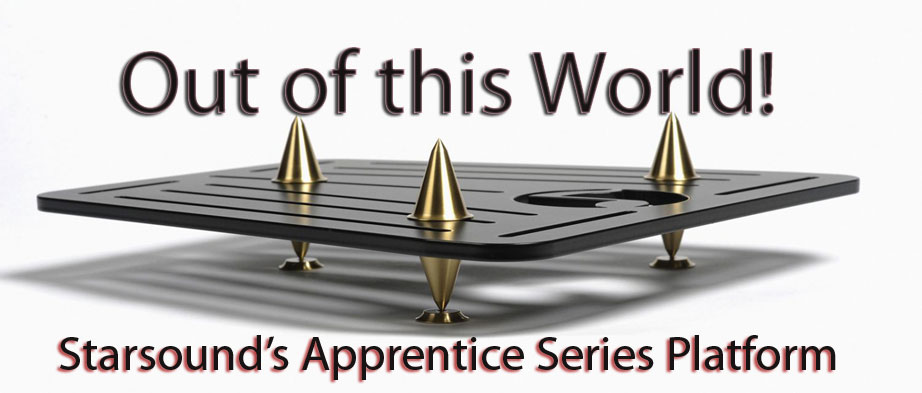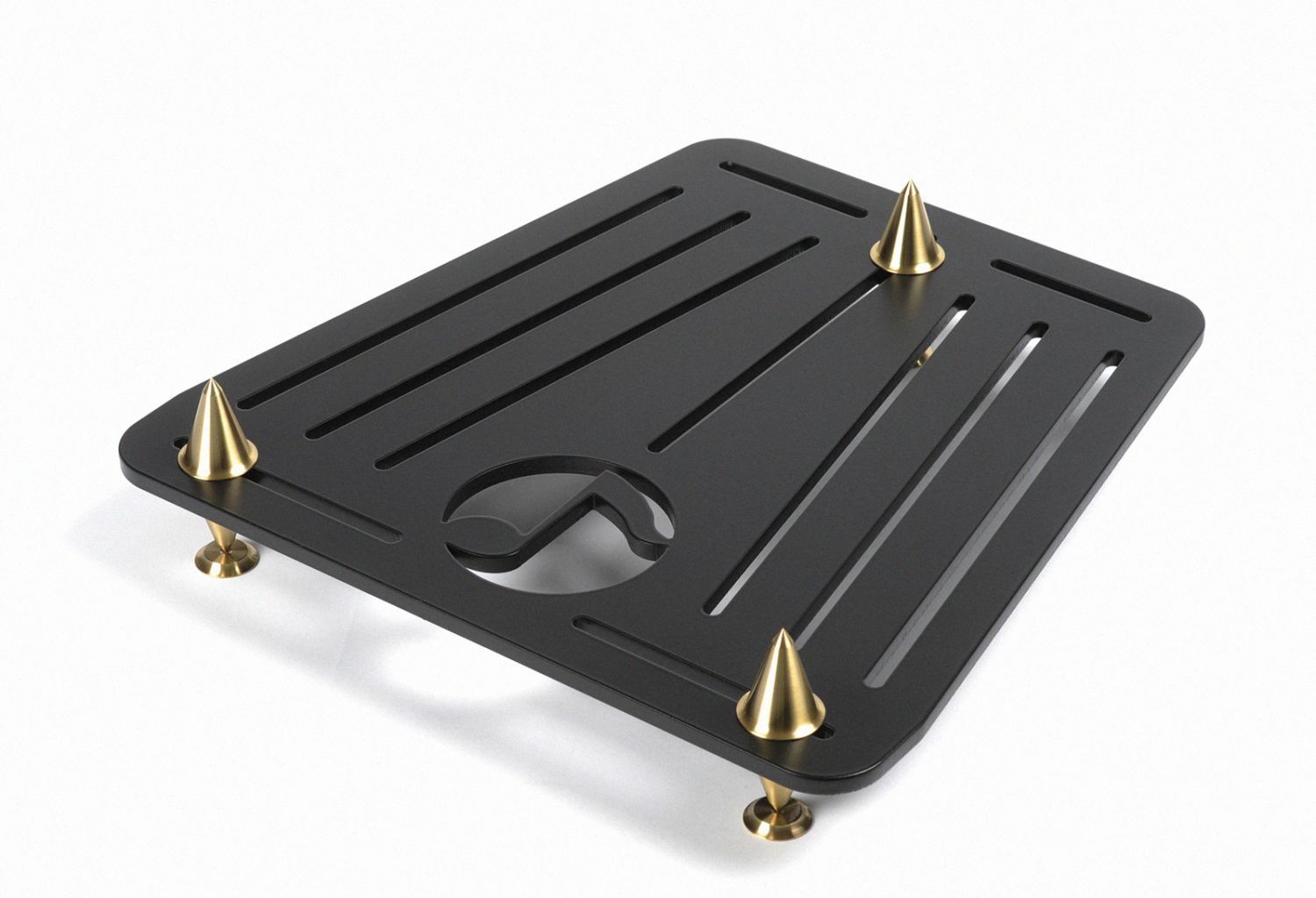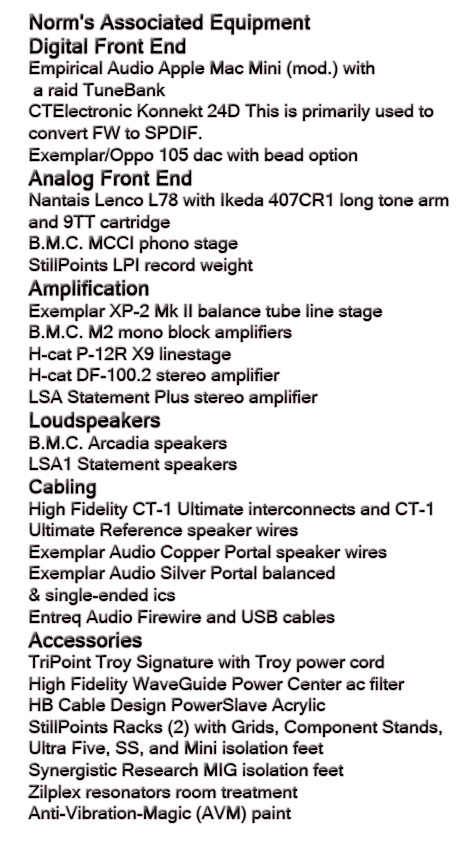Sistrum Apprentice Series SP-SA-103 Platform

 It’s been some time since I first heard about the Star Sound Technologies Sistrum platforms and Audio Points. One person, Tom DeVuono, repeatedly touted these devices. Somehow, nothing much ever materialized out of these contacts. This all ended when I received the Tripoint Troy Signature grounding system,which had nice brass footers.
It’s been some time since I first heard about the Star Sound Technologies Sistrum platforms and Audio Points. One person, Tom DeVuono, repeatedly touted these devices. Somehow, nothing much ever materialized out of these contacts. This all ended when I received the Tripoint Troy Signature grounding system,which had nice brass footers.
Of course, after my many years in audio, I had many brass points lying around, but I thought I remembered that the first version of the Tripoint Troy had Audio Points on it. I asked and found that I was right. I ordered three for use on the Tripoint Troy Signature. My very favorable impression of them on that device caused me to press again for review samples of the platforms from Star Sound Technologies.
The Star Sound Technologies Sistrum Apprentice Series platforms are among their newer products. The SP-SA-103 platforms that I got, have three of their 1 ½” tall Audio Points screwed together on a cut out 5/16” thick steel platform that is 14” deep and from 14” to 10” wide with long cutoutsin which the Audio Point can be moved to optimize the benefits of the Audio Points. These tracks as well as the steel used in the platform, its thickness, and even the powder coating are all designed to maximize the transferring of vibrations out of the components.
My first use was under the BMC Arcadia’s outboard crossovers. These platforms can support up to 800 pounds. There are other shelves in the Star Sound Technologies lines with up to 2” Audio Points and down to .2”.
Beginning with the Audio Points some years ago, the company that has evolved into Star Sound Technologies expanded on the ideas that lead to Audio Points. Their fundamental concept is to get vibrations, coming from electrical, mechanical, and airborne sources, speedily out of the equipment and to the ground. This is at odds with other concepts such as absorbing vibrations and turning them into heat.
I have spent a good deal of money seeking the maximum performance of my components. At the beginning of this review, all of my efforts were focused on the StillPoints “technology,” which is the converting of vertical vibrations into horizontal vibrations, which are converted into heat. I have raved about these devices and still do, but it is a different sound than that with the Star Sound Technologies Sistrum Apprentices.
One might think that the best expression of the Star Sound Technologies philosophy would be to have large steel girders driven into the earth from ones listening room with the components tightly anchored to them, but there are better and worse close ties to the Earth. They go through many tests of the metal in the points and used in the platform as well as the shape, thickness, and even polish or finish of the metal.
My second floor listening room has only “two by fours” in nine-foot lengths to get the vibrations to earth, so you might expect I would not benefit from their use. Nevertheless, as we will discuss, these devices work exceptionally well.

The basic Apprentice Platform would consist of three sets of two Audio Points one with a threaded hole in the center and the other with a threaded bolt that are screwed together. Since three points define a plane and one uses the same height of combined Audio Points this yield a platform that would be parallel to ones floor. One could add a fourth set of Audio Points obviously but many times this would mean that one point would be off the plane of the component’s bottom unless that bottom is precisely flat and your floor flat also. I did not have much luck to using four sets, nor did I find that four, when successful in using them, was clearly better. I do use four under my 198 pound each BMC Arcadia speakers and one was achieved by slightly unscrewing the two Audio Points. Spacer washers are available, but I don’t see how they would help.
 The cutouts in the steel sheet holding the Audio Point vertical is heavily cut with grooves that afford placing the points where they are best, but these cutouts also should mean the shelves have a wide variety of resonances that can cancel each other.
The cutouts in the steel sheet holding the Audio Point vertical is heavily cut with grooves that afford placing the points where they are best, but these cutouts also should mean the shelves have a wide variety of resonances that can cancel each other.
Setup
My system has settled down somewhat. The key elements are either a Koda K10 or an Exemplar XP-2 line stage both used single-ended running a LSA Statement amp, which in turn drives the BMC Arcadia speakers. The power cords are mainly High Fidelity Ultimate Reference Rhodium cords, and the cables, including speaker wires, are all High Fidelity Ultimates Reference. The sources are the Exemplar T105 (Oppo 105), the BMC PureDac, and a Nantais Lenco Reference with Ikeda 407CR1 “long” arm and 9TT cartridge. Vibration isolation started as StillPoints Racks with Grids, Component Stands, Ultra Minis, Ultra SSs, and Ultra Fives. Finally, I have seven Star Sound Apprentice platforms that have been used in succession under my speaker crossovers, my amps, my speakers and finally under the Koda K 10.
Listening Sessions
The Star Sound Tech Apprentice platform’s main first impression is one of speed and dynamics. Especially high frequencies, such as high hat and horns have very quick or sharp leading edges. From the beginning brass sounds right, for the first time. Also piano recordings for the first time sound true. I hasten to note that the HFC power cords have a very low noise floor and also enhance the reproduction of dynamics. Bass is also well defined and deep.
I think it unlikely that there will be more Apprentices used, as I have two Stillpoint ESS racks and only their Grids on each. With no shelves, I could not conceiveof how I might try Apprentice platforms, but a friend, knowing that I had an unused Acapella Fondato Silenzio platform, suggested that I put it on the rails of the rack and the Apprentice on it and a component on top that. I did this with very good results. I must say that presently I have very good sound, a compromise between the dynamics and leading edge of the Star Sound Tech Apprentices and the holographic sound stage of the Stillpoints.
There have been notable moments with inserting the Apprentice Platforms under various components. I first put them under the outboard crossovers of my BMC Arcadia speakers. I noticed that over three days the sound progressively improved. All I can do is to note this “settling in,” as I cannot understand the source of this settling in. But it was to be common in all of the components that I tested on the Apprentices.
 Next with the able assistance of a friend, we put the Arcadias themselves on a single Apprentice Platform. On “Cantate Domino” on the recording of that same name [First Impression Music LIMUHD072], the loud and complex ending with an organ, horns and a large choir is fully resolved with even individual singers apparent. Similarly Wynton Marsalis’ trumpet is ripe and brassy and the drummer’s high hat on the symbols in the background is quite evident in “Basin Street Blues” on Two Men with the Blues. The lack of congestion and the ripeness of brass got even better with putting the Apprentice under electrical components.
Next with the able assistance of a friend, we put the Arcadias themselves on a single Apprentice Platform. On “Cantate Domino” on the recording of that same name [First Impression Music LIMUHD072], the loud and complex ending with an organ, horns and a large choir is fully resolved with even individual singers apparent. Similarly Wynton Marsalis’ trumpet is ripe and brassy and the drummer’s high hat on the symbols in the background is quite evident in “Basin Street Blues” on Two Men with the Blues. The lack of congestion and the ripeness of brass got even better with putting the Apprentice under electrical components.
After having used the Star Sound Apprentice under a prototype amp and noting improvements in the sound stage noticeably as always by making the sound faster and cleaner on the top end, I decided to put my reference LSA Statement Plus amp on a Apprentice platform. Last evening after the very temperamental High Fidelity Ultimate Reference cables had settled down, I listened to some music. What I heard was a strikingly improved sound, far greater than with the other amp. There was more resolution on every cut. The image was strikingly realistic with very precise instrument location both left and right but also with defined depth. I learn from this that there are interactions of the Star Sound Technology with the components on it. Some are greatly improved.
The maker of the prototype amp was surprised that the Apprentice platform had made any difference, as he had used the same techniques to remove vibrations quickly to ground on the ac transformers in the amp. I know that the toroidal transformers in the LSA Statement are pretty solidly mounted, so this has some credence. However, I must say that the LSA amp sounded quite superior to the prototype. But the reader should note that ones experience may vary from what I have experienced.
I guess that I always have noted that virtually all vibration-controlling devices have more impact on some components, but this one is of a much greater magnitude than others I have noted. I should also note that my experience with the BMC Arcadias never found the great improvement I had noted when I had Tidal speakers. The Tidals allowed the StillPoint Ultra Fives to be properly mounted. I never heard the same benefits with the BMCs. So the improved performance of the Star Sound Apprentices under the Arcadias, might be unusual.
I am buying the Apprentices as well as keeping the two StillPoints Racks as they hold the bulk of my sources of music. When Star Sound Tech has a usable rack available, I will, no doubt, request a review sample.


norm luttbeg
Specifications:
Model SP-SA-103
Outside Width: 14” (front), 10” (sides)
Depth: 14”
Shelf Height: .3125”
Overall Height: 3.312”
Price: $399.99
Address:
Star Sound Technologies
1542 North 24th St.
Allentown, Pennsylvania 18104
Phone: (877) 668-4332
Email: sales@starsoundaudio.com
Website: www.starsoundaudio.com
Stereo Times Masthead
Publisher/Founder
Clement Perry
Editor
Dave Thomas
Senior Editors
Frank Alles, Mike Girardi, Key Kim, Russell Lichter, Terry London, Moreno Mitchell, Paul Szabady, Bill Wells, Mike Wright, Stephen Yan, and Rob Dockery
Current Contributors
David Abramson, Tim Barrall, Dave Allison, Ron Cook, Lewis Dardick, Dan Secula, Don Shaulis, Greg Simmons, Eric Teh, Greg Voth, Richard Willie, Ed Van Winkle, and Rob Dockery
Music Reviewers:
Carlos Sanchez, John Jonczyk, John Sprung and Russell Lichter
Site Management Clement Perry
Ad Designer: Martin Perry





Be the first to comment on: Sistrum Apprentice Series SP-SA-103 Platform